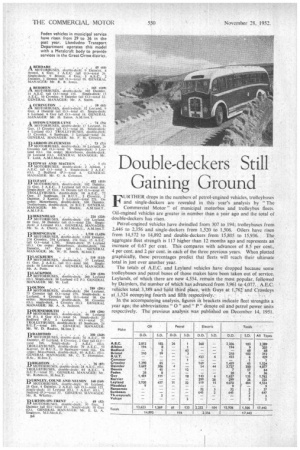Double-deckers Still Gaining Ground
Page 38

If you've noticed an error in this article please click here to report it so we can fix it.
URTHER drops in the numbers of petrol-engined vehicles, trolleybuses and single-deckers are revealed in this year's analysis by "The Commercial Motor" of municipal motorbus and trolleybus fleets. Oil-engined vehicles are greater in number than a year ago and the total of double-deckers has risen.
Petrol-engined vehicles have dwindled from 307 to 194; trolleybuses from 2,446 to 2,356 and single-deckers from 1,520 to 1,506. Oilers have risen from 14,572 to 14,892 and double-deckers from 15,805 to 15,936. The aggregate fleet strength is 117 higher than 12 months ago and represents an increase of 0.67 per ceat. This compares with advances of 8.5 per cent., 4 per cent. and 2 per cent. in each of the three previous years. When plotted graphically, these percentages predict that fleets will reach their ultimate total in just over another year.
The totals of A.E.C. and Leyland vehicles have dropped because some trolleybuses and petrol buses of those makes have been taken out of service. Leylands, of which there are now 4,554, remain the most popular, followed by Daimlers, the number of which has advanced from 3,961 to 4,077. A.E.C. vehicles total 3,389 and hold third place, with Guys at 1,762 and Crossleys at 1.524 occupying fourth and fifth respectively. ' • In the accompanying analysis, figures in brackets indicate fleet strengths a year ago; the abbreviations " 0" and " P " denote oil and petrol power units respectively. The previous analysis was publis'hed on December 14, 1951.




















































































